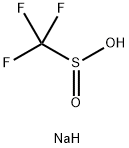TIN(II) TRIFLUOROMETHANESULFONATE
Synonym(s):Sn(OTf)2;Stannous trifluoromethanesulfonate;Tin(II) triflate
- CAS NO.:62086-04-8
- Empirical Formula: C2F6O6S2Sn
- Molecular Weight: 416.85
- MDL number: MFCD00191251
- SAFETY DATA SHEET (SDS)
- Update Date: 2023-04-23 13:52:06

What is TIN(II) TRIFLUOROMETHANESULFONATE?
Chemical properties
White to yellowish powder
The Uses of TIN(II) TRIFLUOROMETHANESULFONATE
Tin(II) trifluoromethanesulfonate is a mild Lewis acid used for stereoselective aldol and Michael reactions; [2,3]-Wittig and Ireland-Claisen rearrangements, Horner-Wadsworth-Emmons reactions, asymmetric [3 + 2] cycloaddition, ring opening reactions and Friedel-Crafts reactions.
Properties of TIN(II) TRIFLUOROMETHANESULFONATE
| Melting point: | ≥300 °C (lit.) |
| storage temp. | Inert atmosphere,2-8°C |
| form | Powder |
| color | White to yellow |
| Water Solubility | Insoluble in water. |
| Sensitive | Moisture Sensitive |
| Stability: | hygroscopic |
| CAS DataBase Reference | 62086-04-8(CAS DataBase Reference) |
Safety information for TIN(II) TRIFLUOROMETHANESULFONATE
| Signal word | Danger |
| Pictogram(s) |
 Corrosion Corrosives GHS05  Skull and Crossbones Acute Toxicity GHS06  Exclamation Mark Irritant GHS07 |
| GHS Hazard Statements |
H302:Acute toxicity,oral H312:Acute toxicity,dermal H314:Skin corrosion/irritation H315:Skin corrosion/irritation H319:Serious eye damage/eye irritation H331:Acute toxicity,inhalation |
| Precautionary Statement Codes |
P261:Avoid breathing dust/fume/gas/mist/vapours/spray. P264:Wash hands thoroughly after handling. P264:Wash skin thouroughly after handling. P270:Do not eat, drink or smoke when using this product. P271:Use only outdoors or in a well-ventilated area. P280:Wear protective gloves/protective clothing/eye protection/face protection. P310:Immediately call a POISON CENTER or doctor/physician. P304+P340:IF INHALED: Remove victim to fresh air and Keep at rest in a position comfortable for breathing. P305+P351+P338:IF IN EYES: Rinse cautiously with water for several minutes. Remove contact lenses, if present and easy to do. Continuerinsing. P405:Store locked up. P403+P233:Store in a well-ventilated place. Keep container tightly closed. P501:Dispose of contents/container to..… |
Computed Descriptors for TIN(II) TRIFLUOROMETHANESULFONATE
New Products
4-AMINO-TETRAHYDRO-PYRAN-4-CARBOXYLIC ACID HCL 4-(Dimethylamino)tetrahydro-2H-pyran-4-carbonitrile 4-Aminotetrahydropyran-4-carbonitrile Hydrochloride (R)-3-Aminobutanenitrile Hydrochloride 3-((Dimethylamino)methyl)-5-methylhexan-2-one oxalate 1,4-Dioxa-8-azaspiro[4.5]decane 5-Bromo-2-nitropyridine Nimesulide BP Aceclofenac IP/BP/EP Diclofenac Sodium IP/BP/EP/USP Mefenamic Acid IP/BP/EP/USP Ornidazole IP Diclofenac Potassium THOMAIND PAPER PH 2.0 TO 4.5 1 BOX BUFFER CAPSULE PH 9.2 - 10 CAP SODIUM CHLORIDE 0.1N CVS ALLOXAN MONOHYDRATE 98% PLATINUM 0.5% ON 3 MM ALUMINA PELLETS (TYPE 73) LITHIUM AAS SOLUTION 2-Bromo-1-(bromomethyl)-3-chloro-5-nitrobenzene 2-Bromo-3-nitroaniline N-(3-Hydroxypropyl)-N-methylacetamide 3-Bromo-6-chloropyridazine 4-ethyl-3-nitrobenzoic acidRelated products of tetrahydrofuran








You may like
-
 Tin(II) trifluoromethanesulfonate CAS 62086-04-8View Details
Tin(II) trifluoromethanesulfonate CAS 62086-04-8View Details
62086-04-8 -
 Tin(II) Trifluoromethanesulfonate CAS 62086-04-8View Details
Tin(II) Trifluoromethanesulfonate CAS 62086-04-8View Details
62086-04-8 -
 Stannous trifluoromethanesulfonate CAS 62086-04-8View Details
Stannous trifluoromethanesulfonate CAS 62086-04-8View Details
62086-04-8 -
 1823368-42-8 98%View Details
1823368-42-8 98%View Details
1823368-42-8 -
 2-(3-(tert-butyl)phenoxy)-2-methylpropanoic acid 1307449-08-6 98%View Details
2-(3-(tert-butyl)phenoxy)-2-methylpropanoic acid 1307449-08-6 98%View Details
1307449-08-6 -
 Ethyl 3-(furan-2-yl)-3-hydroxypropanoate 25408-95-1 98%View Details
Ethyl 3-(furan-2-yl)-3-hydroxypropanoate 25408-95-1 98%View Details
25408-95-1 -
 2-Chloro-5-fluoro-1-methoxy-3-methylbenzene 98%View Details
2-Chloro-5-fluoro-1-methoxy-3-methylbenzene 98%View Details
1805639-70-6 -
 Lithium ClavulanateView Details
Lithium ClavulanateView Details
61177-44-4
Statement: All products displayed on this website are only used for non medical purposes such as industrial applications or scientific research, and cannot be used for clinical diagnosis or treatment of humans or animals. They are not medicinal or edible.